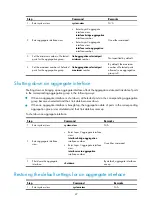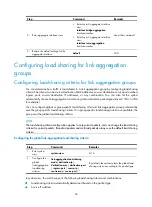
61
Configuring spanning tree protocols
As a Layer 2 management protocol, the Spanning Tree Protocol (STP) eliminates Layer 2 loops by
selectively blocking redundant links in a network, putting them in a standby state, which still also allows
for link redundancy.
The recent versions of STP include the Rapid Spanning Tree Protocol (RSTP), Per VLAN Spanning Tree
(PVST), and the Multiple Spanning Tree Protocol (MSTP).
STP
STP was developed based on the 802.1d standard of IEEE to eliminate loops at the data link layer in a
local area network (LAN). Networks often have redundant links as backups in case of failures, but loops
are a very serious problem. Devices that run STP detect loops in the network by exchanging information
with one another, and eliminate loops by selectively blocking certain ports to prune the loop structure
into a loop-free tree structure. This avoids proliferation and infinite cycling of packets that would occur in
a loop network, and prevents received duplicate packets from decreasing the performance of network
devices.
In the narrow sense, STP refers to IEEE 802.1d STP. In the broad sense, STP refers to the IEEE 802.1d STP
and various enhanced spanning tree protocols derived from that protocol.
STP protocol packets
STP uses bridge protocol data units (BPDUs), also known as configuration messages, as its protocol
packets.
STP-enabled network devices exchange BPDUs to establish a spanning tree. BPDUs contain sufficient
information for the network devices to complete spanning tree calculation.
STP uses the following types of BPDUs:
•
Configuration BPDUs
—Used by network devices to calculate a spanning tree and maintain the
spanning tree topology.
•
Topology change notification (TCN) BPDUs
—Notify network devices of the network topology
changes.
Configuration BPDUs contain sufficient information for the network devices to complete spanning tree
calculation. Important fields in a configuration BPDU include the following:
•
Root bridge ID
—Consisting of the priority and MAC address of the root bridge.
•
Root path cost
—Cost of the path to the root bridge denoted by the root identifier from the
transmitting bridge.
•
Designated bridge ID
—Consisting of the priority and MAC address of the designated bridge.
•
Designated port ID
—Consisting of the priority and global port number of the designated port.
•
Message age
—Age of the configuration BPDU while it propagates in the network.
•
Max age
—Maximum age of the configuration BPDU stored on the switch.
•
Hello time
—Configuration BPDU transmission interval.
•
Forward delay
—Delay that STP bridges use to transit port state.






























